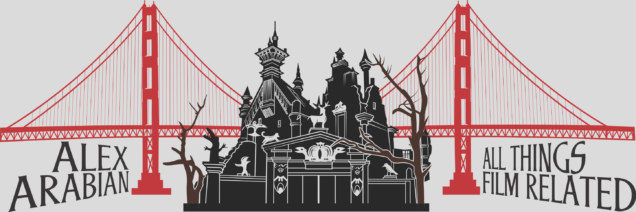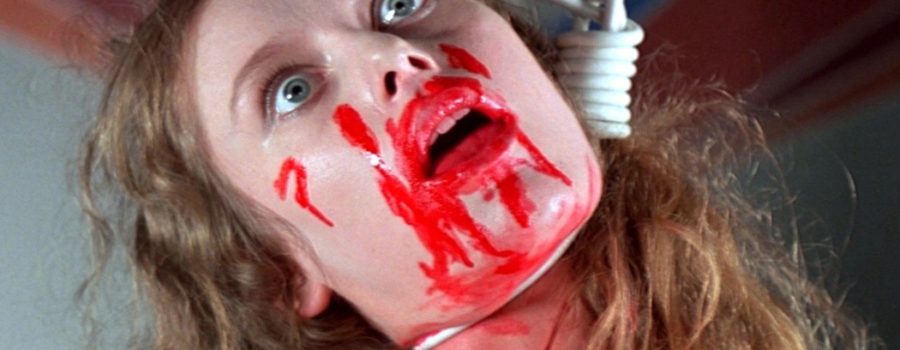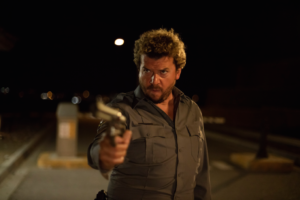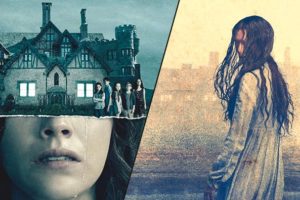[Published at Film Inquiry] For the first time ever in the United States, the uncut version of Suspiria (1977), with an additional six minutes of previously theatrically-banned blood and guts, is screening across the country with a nearly unused 35mm celluloid roll of the Italian film – the way it was meant to be seen. The preserved 35mm print of Suspiria was found in a nearly 40-year-untouched storage room of an old, closed-down Italian cinema by Neil Calderone of the Chicago Cinema Society earlier this year.
I attended only the second screening in the country of the newly found, original Italian version (98 minutes instead of 92 minutes and without English dubbing) at The Roxie Theater in San Francisco. The warmth of celluloid projected on screen using The Roxie’s now-rarely-used, ancient (in film time terms) carbon arc projection process adds to Suspiria’s exuberant imagery. Undoubtedly, Dario Argento’s utilization of space, lighting, a rich color palette, and grandiose set pieces is best seen on the big screen.
Many filmmakers, film critics, film historians, and cinephiles consider Profondo rosso (Deep Red, aka The Hatchet Murders, 1975) to be the greatest Giallo film ever made. However, in my humble opinion, writer and director Argento’s next film, Suspiria, is the most inventive and imaginative horror film ever made, and certainly the best of Argento’s Giallo films. Featuring Goblin’s iconic score and venturing away from the murder mystery plot elements of the prior iterations of the Giallo genre, this time exploring supernatural elements, Suspira is a masterclass in suspense, body horror, and primal, subliminal fear.
Theater Of The Absurd
Suspiria, about an American ballet student, Suzy Bannion (Jessica Harper), who transfers to a prestigious dance academy in Germany, only to find out that the academy is not what it seems, is the first of Argento’s Le Tre madri (The Three Mothers) Trilogy, which is rounded off by Inferno (1980( and La Terza madre (The Mother of Tears, 2007), literally translating in English to “the third mother.” That’s all one really needs to know going into the film. Suspiria is a detailed feast for the eyes, a complex, cerebral film whose execution is nearly perfect thanks to its minimalist plot.

Through Giallo, Argento basically established a movement that redefined and expanded both Italian cinema and the barriers that confined international horror cinema. From Suspiriaonwards, though primarily less focused on the supernatural other than Argento’s La Tre Madri trilogia, Giallo emphasized stylistic elements over plot development in its films. And that is the most important thing to know before seeing Suspiria; it is an absurdist fairytale of witchcraft with a faint hint of noir murder mystery that doesn’t have to make sense.
The film’s narrative fits seamlessly into the plot, as the viewer is essentially taken on the ride of a lifetime from Suzy’s shocked, confused perspective as she tries to navigate through the house of horrors that the dance academy has in store for her. Stylistically, Suspiria represents the purest foundational elements that were essential to the Giallo genre. It is a technical wonder.
An Astounding Technical Achievement
Through Pierangelo Cicoletti’s sleek and shiny costume design, Giuseppe Bassan’s over-the-top, painstakingly intricate, glosssy production design, and Argento’s colorful set pieces amplified by Luciano Tovoli’s vibrant cinematography, the visuals emphasize extremely vivid, almost neon primary colors—particularly red—which makes the violent scenes simultaneously incandescent and terrifying. Interestingly, Argento tasked Tovoli with viewing Walt Disney’s Snow White And The Seven Dwarfs (1937) so that he could emulate the film’s color scheme.
Argento’s intention was to create a purposefully surrealistic, nightmarish vision, which he overwhelmingly achieved. As Suzy frantically meanders through the vast hallways, endless rooms, and hidden, claustrophobic mazes inside the dance academy that are padded with red velvet wallpaper and drapes, Argento’s surging red lighting not only underscores her isolation and panic, but it adds to the film’s pulsating heartbeat, one established hypnotically by Goblin. From the moment Suzy steps into the cab from the airport in the first scene, red reflects upon her face, foreshadowing the carnage about to ensue.
Interestingly, and similarly to Sergio Leone’s and Ennio Morricone’s creative collaborations (of which Argento was a part of in the beginning of his career), Argentoand Goblin composed the score before filming, so Argento built his vision around the sense of sound before anything else (aside from what he imagined in his mind). Accordingly, every frame accompanies the steady, building rhythm that Goblin provides, helping to add a connective tissue to Argento’s meticulously constructed individual scenes. To get the actors onset in the proper mindset, that of an unnerving, naive student fighting for survival, Argento would blast the score during shooting, repeatedly, so as to unsettle them, tapping into an innate, subconscious anxiety.

Admittedly, a few minutes of the cut/extended scenes are excessive (an overextended version of Sara’s infamous, barbed wire death, a brutal massacring of a bat), but the North American version leaves out some rather important background and foundation for the film and The Three Mothers Trilogy. Within the absurdist context that is the world created in Suspiria, upon the umpteenth viewing or so, the film actually makes way more sense than people give it credit for. Every. Single. Detail is painstakingly and purposefully placed in every frame. Speaking of painstaking, almost every frame is flawlessly symmetrical to the extent that it would likely make Wes Anderson envious.
Soft-Subbing Over Dubbing, All Day, Everyday
The majority of an audience, particularly the kind that Suspiria attracts, would tell you that they would rather read English subtitles than listen to the phoniness of the English dubbing; it distracts from the anxious atmosphere that Argento and Goblin’s score creates. It’s, for lack of a better word, frustrating to think that I had become so used to the English-dubbed, 92-minute version to the extent that I forgot the genuineness that the unadulterated, 98-minute version graces the viewer with. With the English voice-dubbing version that was released theatrically in the United States, the audience loses a sense of continuity, believability (in the context of Suspiria’s rather ludacris cinematic world), and flow of the film.
Argento insisted that each actor speak in their native tongue, dubbing it in Italian later; this allowed for a believability through the organic way each actor spoke. Though there were several different languages spoken by the actors onset, it was primarily German and Italian that was heard. In a sense, creating a barrier of language layers the intensifying feeling of hopelessness through the Suzy’s perspective. Even Harper admitted that it assisted in adding depth to her character’s confusion.
Over 90% of the actors speak Italian in the film, but the original version is wonderfully dubbed in Italian, edited to the point that it legitimately looks like the only American actress, Harper, is speaking Italian. Americans, in general, are the least linguistically cultured people in the world, so it’s not a surprise that the American English dubbing is painfully tone deaf. It’s as if the American voice actors were merely reading the lines without any context.
The Embodiment Of Timelessness
Suspiria directly influenced John Carpenter’s Halloween, which, in turn, influenced the entire invention of the horror subgenre that is slasher, primarily in American cinema. It is receiving the remake treatment, as the most of the world knows by now, by acclaimed and fast-rising Italian director, Luca Guadagnino, which is set for a December release date this year, pending how long the composing process takes. Originally, David Gordon Green was attached to the project for nearly ten years, but had trouble securing the rights. Ironically, he chose to remake the next best thing: Halloween. It’s been the most desired, and now, one of most anticipated horror remakes of the last three decades.

Many directors, including Nicolas Winding Refn, have built their entire careers off of, in part, mirroring Argento’s style, technically, aesthetically, and through many elements that characterize the Giallo genre. In fact, The Neon Demon is so close, stylistically, thematically, structurally, and narratively, it might as well be a Suspiria remake. To be candid, I’m genuinely surprised that there wasn’t an intellectual theft lawsuit.
Guadagnino will not keep the same color palette, hinting that this remake will be more grounded in realism. He isn’t using primary colors, let alone neon. This isn’t necessarily a bad thing, but a haunted house horror film void of color seems startlingly unoriginal. That’s a red flag. Guadagnino’s main reason for such a drastic change is because he believes Argento, essentially, blatantly and heavy-handedly emulated Mario Bava’s work to the point of exhaustion with Suspiria. This is somewhat of a revisionist history outlook.
The Inspiration Behind Suspiria
As one of the architects of the slasher genre, Bava’s work indeed influenced Argento, as it did virtually every filmmaker from Martin Scorsese to Quentin Tarantino. Suspiria was looselyinspired by one of Bava’s films, Sei donne per l’assassino (Blood And The Black Lace, 1964), a prelude, of sorts, to the Giallo genre, mainly stylistically through its experimentation with color and violence. However, Bava was more focused on body-count killing (the film’s literal translation is “Six Women For The Killer”) with the specific intention of dehumanizing women. Furthermore, his film had a much more muted color palette than that of Argento’s film.
Bava’s film was one six that inspired Suspiria, the rest being Robert Wiene’s The Cabinet of Dr. Caligari (1920), David Hand’s aforementioned Disney-produced Snow White And The Seven Dwarves (1937), Jacques Tourneur’s Cat People (1942), Neorealism founders Vittorio De Sica and Luchino Visconti, along Mauro Bolognini, Pier Paolo Pasolini, and Franco Rossi’s Le streghe (The Witches, 1967), and Brian De Palma’s Phantom Of Paradise(1974), which Harper also starred in.
Think of giallo, from an international perspective, as a murder mystery genre. The name means “yellow” in English, referencing the anthology of crime-mystery pulp novels: Il Giallo Mondadori, or The Yellow Mondadori (Mondadori was the name of the publishing company). These chronicles were known for their characteristically yellow book covers. Essentially, most noir novels or films from any country are considered giallo (Peeping Tom, UK, Vertigo, US, Mannequin in Red, Sweden).

American and UK audiences consider Giallo (for the sake of clarity, I’ve capitalized the English characterization genre label to separate the two) to be a specific, Italian cinematic version of the trope, the ultra-violent, colorful, sex-infused murder mysteries; they were, at their core, tasteful slasher films. However, Italian audiences consider their Giallo films to be “spaghetti thrillers,” or, what most international audiences might refer to today as the B movie horror genre (Plan 9 From Outer Space, Dead Alive, the aforementioned Cat People, Chopping Mall, etc.).
A Starkly Contrasted Remake In Store – For Bettor Or For Worse
Contrary to Argento and Goblin’s process, the Suspiria remake has already been shot, and Guadagnino has only just chosen a composer: Thome Yorke, the frontman of the band, Radiohead. According to an interview with BBC Music 6, Yorke appears overwhelmed with the assignment he’s being given: “Normally [scoring] a horror movie involves orchestras, these specific things…But Luca, the director, and Walter [Fasano], the editor, are very much, like, find your own path with it…I just have to find a way into it…It’s absolutely terrifying…It’s hard because I’m way out of my comfort zone and I can’t read music, so it’s not like I’m writing for orchestra. I’m building it all myself. In fact, I watched Blade Runner twice at the weekend. ‘Oh, that sound, I could do something like that, that’s quite easy…I’ll rip that bit off there and that bit there and I’ll be fine.’” You’re on the right track. Kind of. Sort of. Not really. Another red flag.
It’s possible Guadagnino might have set himself up for a disconnect that could lead to a monumental failure in his remake as a result of giving Yorke too much creative freedom. While the greatest artists take inspiration from prior maestri before them and find a way to make it new again by adding their own touch, Yorke isn’t even in the right genre yet, mentally.
Alright, I may not be a member of the world-renowned band, Radiohead, but I can read music and happen to know a wee bit about film. My point is, anyone can read and compose music, but the intangible part of film composing as an art form is being able to relate to and communicate with the director in a way that you, as the composer, understand completely his or her intended tone and subtexts, studying each shot meticulously beforehand to grasp a director and composer synergy so that the music expresses the director’s vision on a cellular level; so that it seeps into the subconscious of the audience, assisting in articulating the film’s themes.
And that director-composer collaboration is just happening now, as one of post-production’s final phases. It appears there was never an official spotting session before production, Guadagnino didn’t even have an idea of how the score would sound, and music is paramount in executing a film’s tone. Another red flag. Music can single-handedly hinder a film’s success. My unsolicited advice to Yorke would be to maybe not take his inspiration from Blade Runner; apart from being in an entirely different genre that tackles opposing themes, it is has a vastly different aesthetic and cinematic tone. It might be more advisable to watch the original Suspiriamore than a few times, or, for that matter, grasp a basic knowledge of horror film scoring. Do your research. Don’t rush.

Although, given the last-minute pressure Guadagnino is putting on him, it will be difficult for Yorke take the necessary time to do the proper research to climb the film scoring learning curve and be on the same page as Guadagnino. It’s a complete gamble at this point, akin to a Hail Mary football throw in American football as the clock runs out in the fourth quarter, with a desperate, blind hope of winning the game.
As for Guadagnino, the talented auteur has made some successful and poignant films, though mostly dramatic works, and some bordering on superfluous melodrama (Io sono l’amore, or I Am Love, 2009). Not every director has the capability to dive head-first into horror filmmaking, particularly if it’s a genre that he or she doesn’t have enough of a knowledge of to begin with, and especially since its a film that probably shouldn’t be remade in the first place.
However, all of these factors aren’t necessarily a bad thing. Some of the best works come from surprise collaborations. Guadagnino might just have something very special up his sleeve. Perhaps that’s why the marketing surrounding the project has been so secretive. Since I’m using American sports analogies already, think of it this way: just like some of baseball’s greatest players, talented artists can pull off some of their best work in the bottom of the 9th inning when their backs are against the wall. Some even exceed expectations, so, let’s all hope Guadagninoproves me wrong and hits a home run, running his victory lap around the bases during awards season.
A Glorious Giallo Guise
The original Suspiria will never lose its fever pitch charm. The fact that the demand to see the film on celluloid in theaters 40 years after its release speaks volumes about its enduring impact on subsequent generations. Aside from the cultural impact, it’s the little trivial details that add to the film’s mysticism; random facts like Argento’s intentional placement of every doorknob of the academy at the eye-level 0f the female actors, magnifying the audience’s subconscious interpretation of the characters’ childlike naiveté. Or that Suspiria was the first Italian film to use the Steadicam technology for image stabilization. Or how Argento shot Suspira on Eastmancolor Kodak stock, then printed the film using the three-strip Technicolor process, utilizing one of the last remaining three-strip machines. After that, the three-strip process became obsolete. Yet, it lives on through this film.
Similarly, Giallo, an almost extinct genre, lives on through the story of Suspiria. Like the titular word’s Italian meaning, “to sigh,” its exuberance and eccentric execution will always linger in the back of the minds of cinephiles, just as Goblin member, Claudio Simonetti’s hauntingly unintelligible, albeit chilling background whispers throughout the film do to the Suspiria’saudience. For the first time in years, I got an unsettling chill sent down my back in the moment leading up to the shocking climax when Suzy slowly walks through the hidden corridor to an uncertain fate. As far as terror-inducing moments, Suspiria still holds its own, even after 40 years.
Do not miss Suspiria on the big screen, how it was intended to be seen. It’s an immersive experience, not just a theatrical screening. The scares, the jumps, the diversity of Argento’sdense color scheme, the innovative, vertigo-inducing camera angles, the macabre bursts of violence, and the booming score on surround-sound all wonderfully enhance the film to its full potential.
Are you a fan of Argento and Giallo? Do you think Suspiria is Argento’s cappolavoro? Are you optimistic or apprehensive about Guadagnino’s upcoming remake? Tell you in the comments below!
Suspiria is currently screening across the United States. Find out if it’s playing near you at Chicago Cinema Society!








Leave a Reply
Your email is safe with us.